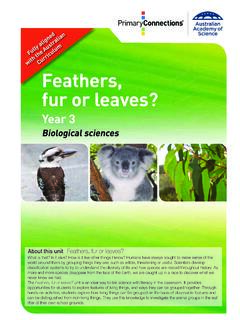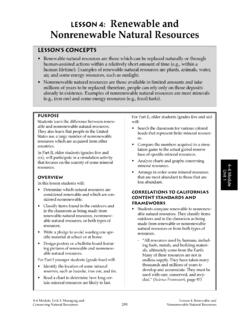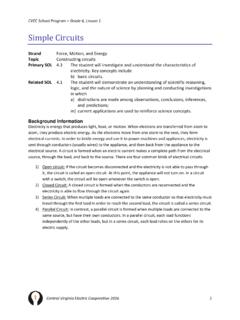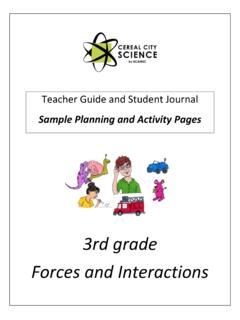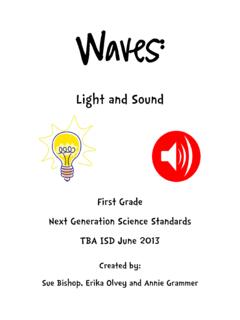Transcription of Weather in my world - PrimaryConnections
1 N ed lian a lig stra u lly Au lum F the icu r i th ur w C. Weather in my world Foundation Year Earth and space sciences About this unit Weather in my world Each day the Weather affects our work and leisure activities. The Weather influences our decisions about what to wear and the things we do. Severe Weather phenomena such as droughts, floods and cyclones have serious impacts on communities. Horticulture, farming, fishing and tourism are highly dependent on Weather . The accurate prediction of Weather patterns and interpretation of Weather forecasts are very important to our economy and lifestyle. The Weather in my world unit is an ideal way to link science with literacy in the classroom. Students' beliefs and understanding about the air, Sun and wind will be developed as they work through hands-on activities. Through investigations, they will increase their knowledge of how the characteristics of Weather affect their daily lives.
2 Australian Academy of Science, July 2012. Revised June 2020. Except as set out below or as allowed under relevant copyright law, you may not reproduce, communicate or otherwise use any of this publication in any of the ways reserved to the copyright owner without the written permission of the Australian Academy of Science. For permissions, contact PrimaryConnections . Educational purposes If you work in an Australian educational institution, you may be able to rely on the provisions in Part VB of the Copyright Act 1968 (Cth) to photocopy and scan pages of this publication for educational purposes. These provisions permit a reasonable portion of a publication to be copied (usually, 10% or 1 chapter, but more if this publication is not commercially available in a reasonable time at an ordinary commercial price). Notwithstanding the above, the individual teacher or organisation that purchased this publication new may photocopy or print out those pages that are marked Resource sheet to give hardcopy copies to his, her or its own students to use.
3 Australian education users may freely use this material for non-commercial educational purposes. Published by the Australian Academy of Science. GPO Box 783. Canberra ACT 2601. Telephone: 02 6201 9400. Email: Typesetter: Sharyn Raggett Font: Helvetica Neue, DIN. Print house: Daniels Printing Craftsmen Cover images: ISBN 978 0 85847 684 4. Acknowledgments PrimaryConnections is supported by the Australian Government. Thanks to the trial teachers and students of the trial schools Australia-wide and Fellows of the Australian Academy of Science who contributed to this unit . All material identified by is material subject to copyright under the Copyright Act 1968 (Cth) and is owned by the Australian Curriculum, Assessment and Reporting Authority 2020. For all Australian Curriculum material except elaborations: This is an extract from the Australian Curriculum. Elaborations: This may be a modified extract from the Australian Curriculum and may include the work of other authors.
4 Disclaimer: ACARA neither endorses nor verifies the accuracy of the information provided and accepts no responsibility for incomplete or inaccurate information. In particular, ACARA does not endorse or verify that: The content descriptions are solely for a particular year and subject;. All the content descriptions for that year and subject have been used; and The author's material aligns with the Australian Curriculum content descriptions for the relevant year and subject. You can find the unaltered and most up to date version of this material at This material is reproduced with the permission of ACARA. Disclaimers The views expressed herein do not necessarily represent the views of the Australian Government. These materials are intended for education and training only. Every effort is made to ensure the accuracy of the information presented in these materials. We do not assume any liability for the accuracy or completeness of the information contained within.
5 The Australian Academy of Science accepts no liability or responsibility for any loss or damage whatsoever suffered as a result of direct or indirect use or application of any of these training materials. ii Contents The PrimaryConnections teaching and learning approach v unit at a glance viii Weather in my world Alignment with the Australian ix Curriculum Teacher background information xvi Lesson 1 Wondering about the Weather 1. Lesson 2 Watching the Weather 5. Lesson 3 Eye to the sky 17. Lesson 4 What's the Weather like today? 23. Lesson 5 My Weather book 31. Lesson 6 Investigating the wind 37. Lesson 7 Weather reporters 47. Appendix 1 How to organise collaborative learning teams (F Year 2) 51. Appendix 2 How to use a science journal 55. Appendix 3 How to use a word wall 57. Appendix 4 How to conduct a fair test 59. Appendix 5 Weather in my world equipment list 60. Appendix 6 Weather in my world unit overview 62. iii Foreword Never has there been a more important time for science in Australia.
6 More than ever, we need a scientifically-literate community to engage in debates about issues that affect us all. We also need imaginative thinkers to discover the opportunities in our exponentially expanding knowledge base. Teachers play a vital role in nurturing the minds of our future citizens and scientists. The Australian Academy of Science has a long, proud history of supporting science education. Our primary education program, PrimaryConnections : linking science with literacy, now has over 15 years' experience in supporting teachers to facilitate quality learning experiences in their classrooms. Regular evaluations demonstrate the significant impact the program can have on both teacher confidence and student outcomes. PrimaryConnections has been developed with the financial support of the Australian Government and endorsed by education authorities across the country. It has been guided by its Steering Committee, with members from the Australian Government and the Australian Academy of Science, and benefitted from input by its Reference Group, with representatives from all states and territories.
7 Key achievements of the program include engaging over 24,000 Australian teachers in professional learning workshops, producing multi award-winning curriculum resources, and developing an Indigenous perspective framework that acknowledges the diversity of perspectives in Australian classrooms. The PrimaryConnections teaching and learning approach combines guided inquiry, using the 5Es model, with hands-on investigations. It encourages students to explore and test their own, and others', ideas and to use evidence to support their claims. It focuses on developing the literacies of science and fosters lasting conceptual change by encouraging students to represent and re-represent their developing understandings. Students are not only engaged in science, they feel that they can do science. This is one of 40 curriculum units developed to provide practical advice on implementing the teaching and learning approach while meeting the requirements of the Australian Curriculum: Science.
8 Trialled in classrooms across the country and revised based on teacher feedback, and with the accuracy of the teacher background information verified by Fellows of the Academy, the experience of many brings this unit to you today. I commend PrimaryConnections to you and wish you well in your teaching. Professor John Shine, AC Pres AA. President (2018 2022). Australian Academy of Science Weather in my world The PrimaryConnections teaching and learning approach PrimaryConnections units embed inquiry-based learning into a modified 5Es instructional model. The relationship between the 5Es phases, investigations, literacy products and assessment is illustrated below: PrimaryConnections 5Es teaching and learning model Phase Focus Assessment focus ENGAGE Engage students and elicit prior knowledge Diagnostic assessment EXPLORE Provide hands-on experience of the phenomenon Formative assessment EXPLAIN Develop scientific explanations for observations and Formative assessment represent developing conceptual understanding Consider current scientific explanations ELABORATE Extend understanding to a new context or make Summative assessment connections to additional concepts through a student- of the Science Inquiry Skills planned investigation EVALUATE Students re-represent their understanding and reflect Summative assessment on their learning journey, and teachers collect evidence of the Science Understanding about the achievement of outcomes More information on PrimaryConnections 5Es teaching and learning model can be found at: Reference: Bybee, (1997).
9 Achieving scientific literacy: from purposes to practical action. Portsmouth, NH: Heinemann. Developing students' scientific literacy The PrimaryConnections program supports teachers in developing students' scientific literacy. Scientific literacy is considered the main purpose of school science education and has been described as an individual's: scientific knowledge and use of that knowledge to identify questions, acquire new knowledge, explain scientific phenomena and draw evidence-based conclusions about science-related issues understanding of the characteristic features of science as a form of human knowledge and enquiry awareness of how science and technology shape our material, intellectual and cultural environments willingness to engage in science-related issues, and with the ideas of science, as a reflective citizen. Reference: Programme for International Student Assessment & Organisation for Economic Co-operation and Development.
10 (2009). PISA 2009 assessment framework: key competencies in reading, mathematics and science. Paris: OECD Publishing. v PrimaryConnections Linking science with literacy PrimaryConnections has an explicit focus on developing students' knowledge, skills, understanding and capacities in science and literacy. Units employ a range of strategies to encourage students to think about and to represent science. PrimaryConnections develops the literacies of science that students need to learn and to represent their understanding of science concepts, processes and skills. Representations in PrimaryConnections are multi-modal and include text, tables, graphs, models, drawings and embodied forms, such as gesture and role-play. Students use their everyday literacies to learn the new literacies of science. Science provides authentic contexts and meaningful purposes for literacy learning, and also provides opportunities to develop a wider range of literacies.
